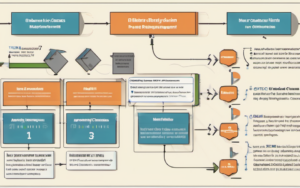The world of finance is undergoing a seismic shift, driven by the revolutionary technology known as Blockchain. This groundbreaking innovation, at the heart of cryptocurrencies like Bitcoin, has sparked a digital gold rush, transforming how we think about money, security, and trust. Understanding the early days of this technology is crucial to grasping its present potential and future impact.
1. The Dawn of Decentralization
The seeds of the Blockchain revolution were sown in the wake of the 2008 financial crisis. A sense of distrust in centralized financial systems was rampant. This paved the way for the development of a decentralized alternative.
The birth of Bitcoin, in 2009, marked a pivotal moment. Created by the pseudonymous Satoshi Nakamoto, Bitcoin introduced a revolutionary concept: a peer-to-peer digital currency that bypassed traditional banking institutions. This early cryptocurrency leveraged Blockchain’s inherent security, transparency, and immutability, features that would become central to its appeal and the subsequent boom.
Early adoption of Bitcoin was largely driven by cypherpunks and tech enthusiasts fascinated by its decentralized nature and potential to disrupt the established financial order. These early adopters formed a vibrant online community, fostering innovation and helping to spread awareness about the technology’s potential. They saw in Bitcoin, and the underlying Blockchain technology, a solution to the problems of centralized control and financial censorship. The understanding of the early cryptocurrency adoption was vital to the technology’s subsequent development.
2. The Wild West of Crypto
The initial years following Bitcoin’s launch were characterized by rapid growth and significant volatility, a period often described as the “Wild West” of crypto. The introduction of the first cryptocurrency exchanges and trading platforms created new opportunities for investment and speculation. This marked the start of a period of rapid innovation and experimentation within the Blockchain space.
The emergence of altcoins, alternative cryptocurrencies built on various Blockchain platforms, added further complexity and dynamism to the market. This proliferation of new projects spurred a wave of both excitement and skepticism. The rapid growth of the crypto market was further fueled by the expansion of Decentralized Finance (DeFi). DeFi applications leveraged Blockchain technology to create decentralized financial services, bypassing traditional intermediaries and offering novel ways to borrow, lend, and invest. This expansion demonstrated the potential for Blockchain to revolutionize not just currency, but the entire financial ecosystem. Understanding these early stages is key to comprehending the current cryptocurrency investment opportunities.
3. The Impact of Blockchain Beyond Cryptocurrency
While cryptocurrencies remain the most visible application of Blockchain technology, its potential extends far beyond the realm of finance. The technology’s ability to create secure, transparent, and immutable records has significant implications for various sectors.
Supply chain management is one area where Blockchain is already making a tangible impact. By creating a shared, transparent ledger, Blockchain can track goods and materials throughout the entire supply chain, improving traceability and reducing the risk of fraud. This added transparency builds trust and efficiency, helping businesses improve their supply chains and enhance consumer confidence.
Digital identity is another area ripe for Blockchain-based solutions. The technology can be used to create secure, verifiable digital identities, protecting individuals from identity theft and improving data security. This is vital in an increasingly digital world where personal information is constantly being collected and shared.
The potential for decentralized governance is perhaps the most transformative aspect of Blockchain technology. Blockchain can facilitate the creation of transparent, democratic organizations, enabling greater participation and accountability. This has implications for everything from government and elections to community management and corporate structures. Exploring these applications helps in understanding the digital gold rush explained.
4. The Future of the Digital Gold Rush
The future of Blockchain technology and its associated cryptocurrencies is uncertain, but the potential for disruption is undeniable. Regulation will play a critical role in shaping the future of the industry, both fostering innovation and protecting consumers. Governments and regulatory bodies worldwide are grappling with how best to regulate this nascent technology, balancing the need for innovation with the need for consumer protection.
The potential for Blockchain to disrupt various industries is vast and varied. From finance and supply chain management to healthcare and voting systems, the technology holds the potential to transform how we interact with and manage information. Understanding the potential for this disruption is key to anticipating the future and participating in the shaping of the technological landscape.
Blockchain’s role in shaping the future is likely to be multifaceted and far-reaching. The technology is still in its early stages of development, and its full potential remains to be seen. Yet, its transformative power is already evident in its ability to create trust, transparency, and security in a world increasingly reliant on digital systems. The early days of Blockchain and cryptocurrency represent just the beginning of a technological revolution that will continue to unfold in the years to come. The “digital gold rush” narrative, while apt in describing the initial excitement and rapid growth, understates the long-term potential of this disruptive technology to reshape the world.




